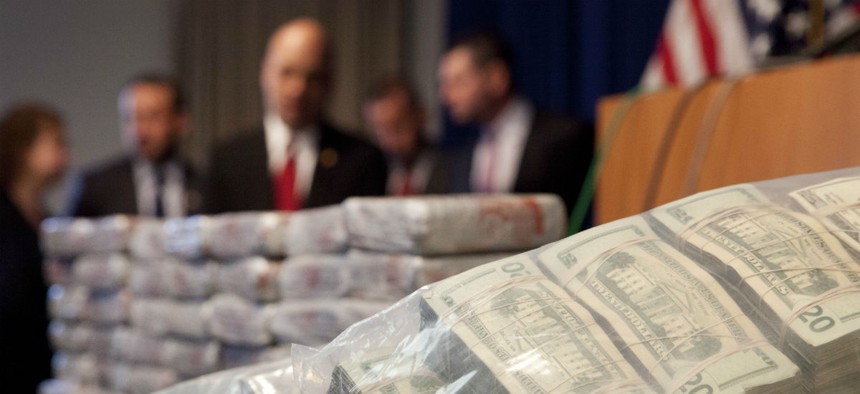
DEA officials hold a news conference on a large heroin seizure in New York state. Mark Lennihan / AP
The DEA is Leaving Its Drug Seizures Vulnerable to Theft
The agency is compromising prosecutions and the security of the drugs, report finds.
The Drug Enforcement Administration is leaving the illicit drugs it seizes vulnerable to theft or tampering, according to a new report.
The DEA is not properly documenting, tracking or relocating its intake of seized drugs, the Justice Department’s inspector general said in findings released Thursday. The agency’s shortcomings have compromised the security of the drugs, the auditor said, as well as their utility as evidence in court.
Nearly 70 percent of drug seizures examined by the IG were placed in temporary storage for more than the maximum of three days, according to the report. During that period, the drug “exhibits” are not entered into the comprehensive tracking system. Additionally, the IG said, the DEA is not properly tracking the third-party shipping vendors required when the laboratory the seizures are sent to is far enough away.
“We believe that the longer a shipment is in transit or missing,” the IG wrote, “the higher the likelihood that theft or tampering of the drug exhibit can occur.”
In some cases, the DEA could not locate the documentation relating the drugs at all. The formal receipt that tracks incoming drug seizures is referred to as a DEA-12, and the agency could not locate the documents in 9 percent of the cases investigated by the IG.
“Gaps in the formal documentation of the chain of custody for drug exhibits can compromise the security of the drugs and jeopardize the government’s ability to use the evidence in court proceedings,” the IG said.
In other instances, the DEA was not recording the full information relating to the exhibits. More than half of the “reports of investigation,” or DEA-6 forms, examined by the auditors did not list the total weight of the drugs seized. If drugs were subsequently tampered with, DEA officials would have no way to know. About one in 10 of the forms did not list the witness of the seizure, an important detail when forming a case to prosecute criminal activity.
The requirements to document details like weight and witnesses ensure “the integrity of the exhibit for prosecution, minimize suspicions regarding the theft or loss of drugs during the seizure process and provide a benchmark for future weight calculations,” the IG said.
The DEA did not document some forms in a timely manner, further elevating the risk of compromising the exhibits. More than three in 10 of the “reports of drug property collected, purchased or seized” were not completed in the required time period, while an additional 9 percent never recorded that the drugs were moved to temporary storage. The IG said DEA procedures “generally were appropriate,” but by failing to consistently meet their standards they risked their drug seizures being misplaced or stolen.
The inspector general made nine recommendations in total to improve the oversight of DEA drug seizures, all of which the agency agreed to address.
NEXT STORY: Here's Why the FBI Can't Hack into the iPhone







